|
SpaceTides
Newsletter #33 - 18 July 2005
Internet
Newsletter of ASSA Bloemfontein Centre,
South Africa, to the public
www.assabfn.co.za/spacetides
|
In this issue of SpaceTides
|
INDEX
1. Spaceflight news from around the world
2. Astronomy news from around the world
3. Interesting space facts
4. Space questions
5. Sky Observation log
6. Astronomy news in Southern Africa
7. Astronomy events in the City of Bloemfontein
8. Web links & Net nodes
Dear SpaceTides subscribers
As you know, the Deep Impact impactor probe
successfully hit comet Tempel 1 and
as some might have read, the Shuttle did not launch on 13 July
due to technical precautions. A few other interesting findings
took place during the past few weeks - you can read some of them
below.
An e-mail hoax is doing the rounds, stating that the planet Mars
will come very close to Earth in August and appear "as big
as the full moon". Please ignore any such e-mails, they are
false. Most of it was applicable to August 2003 when Mars did
get closest to Earth in thousands of years, though it wasn't nearly
as big or bright as the full moon. In fact, people who did not
frequently observe Mars, didn't even
notice a difference. If I get the guy/girl who started that e-mail!
(if you know his/her name, kindly send it to me :)
Remember
the Boyden Observatory open-evening on the 23rd of July (Saturday).
Reservation details under section 7 below.
Have a
star-filled week!
Gerrit
Penning
Editor
|
Total
subscribers as at 16 July 2005: 213 (+76 since issue 32)
|
1. Spaceflight news
from around the world
|
|
Spaceflight in short:
- The launch of Space Shuttle
Discovery's return-to-flight mission to the international space
station was called off on July 13,
on accounts of a faulty hydrogen fuel sensor.
- The international
ASTRO-E2 X-Ray Observatory spacecraft launched on a Japanese
M-5 rocket from the Japanese
Uchinoura
Space Center on 10 July 2005 after
the first attempt in 2000 was unsuccessful.
|
|

Image
credit: NASA-KSC
|
Launch of Shuttle
Discovery Postponed
Read full article at: www.spaceflightnow.com/shuttle/sts114/050715postmmt/
After
much anticipation, the 13 July planned launch of Shuttle Discovery
was called off due to a faulty fuel sensor.
The badly behaving fuel sensor was identified during a pre-launch
test.
Official
flight rules forbid a Shuttle launch from going ahead if all four
the fuel depletion sensors are not operating normally.
NASA now has 12 teams of dedicated personnel working hard to isolate
the problem and prevent it from occurring again. Plans are still
in motion to launch the Shuttle in July 2005 towards the International
Space Station.
|
|
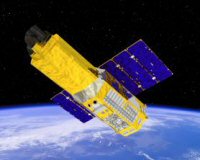
The Suzako
X-Ray observatory
Image credit: ISAS/JAXA
|
ASTRO-E2 X-Ray Observatory into space
Homepage:
www.nasa.gov/lb/mission_pages/astro-e2/main/index.html
The "Suzako" X-Ray Observatory was successfully launched
on July 10, 2005.
Five years ago in 2000, a first
attempt was made to launch such a satellite, but a launch failure
occurred and the craft never made it into space. Suzako
will build on the work done by the famous Chandra X-ray observatory
and will use spectroscopy to study the "colours" of X-ray
light. Researchers will use its sensitivity and high resolution
equipment in the X-ray energy range to learn more about supermassive black holes, active and merging galaxies, neutron
stars and supernova remnants. Japan
and the USA
collaborates on the project.
|
|
2. Astronomy news from
around the world
|
|
Astronomy in short:
- Deep Impact findings:
a great plume of very fine powdery materials appeared after impact
on July 4, but the plume slowly faded in the next few days after
which the comet's look returned to normal. A lot of research is
still going on however.
-Astronomers
using the Keck I telescope discovered a gas giant exoplanet in
a solar system 149 light-years away. The planet finds itself in
a triple-star system.
|
|
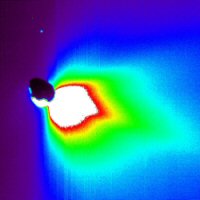 Plume
of comet materials visible. Plume
of comet materials visible.
Credit: NASA/JPL-Caltech/UMD
|
Report-back on first Deep Impact Findings (8 July
2005)
More
information at: www.spaceflightnow.com/deepimpact/050708powder.html
Gigabytes of
information was
collected during the crash of the Deep Impact probe into comet Tempel 1 on July 4, 2005. The explosion resulted in
huge amounts of very fine powdery material being thrown out into
space.
At this stage it seems that the probe might not have made such a
large impact on the comet as hoped in order to expose a lot of the
"pristine material" beneath the comet's surface: the materials
the scientists are mostly interested in. The crater that was created
however, is believed to be quite deep.
The plume of dust faded in the next few days after impact and the
comet's "look" returned to normal. Scientists will
spend much time going through the thousands of photographs and the
other data collected during and after impact.
|
|
 Credit:
Caltech (artist impression) Credit:
Caltech (artist impression)
|
Exoplanet in a three-star solar system discovered
Full
article: www.jpl.nasa.gov/news/news.cfm?release=2005-115
(July 13, 2005)
A
new planet far outside our own solar system (149 light years away)
has been discovered, which is situated in a triple-star solar system.
Imagine our sky having not just one, but three suns at the same
time! The sky of this "exoplanet" will appear strange
by sometimes having all three stars (suns) in the sky at once. The
planet was discovered using the large Keck I telescope in Hawaii.
More than half of all stars are either double or multiple systems
(unlike our own Sun which does not have any companion stars).
The exoplanet is slightly more massive than Jupiter and also consists
of gas.
|
|
3. Interesting Space
Facts
|
|
- The planet Mercury was named after the speedy
messenger of the gods by the Romans, because it appeared to move
more quickly than any other planet visible. Mercury takes only 88
days to orbit the Sun, compared to 365 days for the Earth.
Mercury's diameter is 40% smaller than the Earth's and 40% larger
than our Moon's.
- If the planet Neptune
were hollow, it could contain almost 60 Earths! It orbits the
Sun once every 165 years. Neptune
also holds the record for the fastest winds in the solar system:
they can blow up to 2 000 km/h!
- It is possible
to see the International Space Station from Earth. It orbits
about 350 km above the surface and is visible as a bright speck
of light when travelling over your location (looking like a bright
satellite). Times are available at www.heavens-above.com by typing in or
searching for your location.
|
|

|
Does the Earth's rotation have
any effect on the speed of aircraft?
The
Earth's rotational speed (1 600 km/h) has no direct effect on the
speed of aircraft traveling in the atmosphere,
because the atmosphere (and the aeroplane in it) is carried along
with the Earth as it spins. The only way in which aircraft
speed can be influenced by the Earth's spin (and then only slightly
compared to the overall speed of the Earth), is through the "Coriolis"
effect of wind patterns created by the Earth's rotation. Source: www.physlink.com/Education/AskExperts/ae687.cfm
|
|
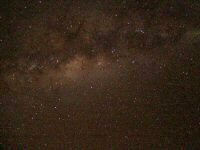
|
How many stars can you see with
the naked eye on a dark night?
You can see about 3 000 stars with your naked eye. There are in
fact, between 200 billion and 400 billion stars in our Milky Way
galaxy alone (mostly too far and too faint to see though and the
figure may change as new research takes place).
Our
nearest star, Alpha Centauri is a triple star, with its smallest
member "Proxima Centauri" being the closest to our Sun
(4.3 light years away). "Barnard's star" (a faint red
dwarf) is the second nearest.
|
|
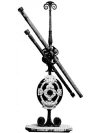
Galileo's
Telescope
|
Who invented the telescope?
Unlike
popular believe, Galileo Galilei did not
invent the telescope. He was only the first person to use it for
recorded astronomical purposes from 1609. It is unsure who
exactly invented the telescope, but there was a Dutchman named Hans Lippershey who in 1608 gave the government an instrument for military
use, which had two lenses in a tube (to magnify the image looked
at) - a primitive telescope. Other opticians also worked on the
concept, but ou Hansie got the patent!
Source: http://space.about.com/cs/basics/a/spacefaq12.htm
|
|
The value of binoculars for sky watching
The power of the
binocular for sky watching is frequently undervalued. Binoculars
are however, the most versatile and user-friendly instruments to
use for sky watching. There are some objects in the sky that is
best suited for observation through a binocular - they are just
too large for telescopes. Examples include M45 (the seven sisters)
in Taurus, M7 in Scorpio and the Beehive cluster M44 in Cancer.
You will also be awe-inspired when you take a glimpse of the milky
way through a binocular. Hundreds of background stars suddenly resolves
into fantastic images.
Now is the time for Scorpius
and Sagittarius
If you haven't
looked at Scorpius and Sagittarius yet, now is the time to do so.
Scorpius (the Scoprion) is situated
almost right above your head at the moment in the evenings (at your
"zenith"), with Sagittarius just below it to the east.
Have a look at them and while you're
busy watching, take a binocular and scan the area for the many deep
sky objects found in these two object-rich constellations. Skymaps
can be found at: http://skymaps.com/
|
|
6. Astronomy News in
Southern Africa
|
|
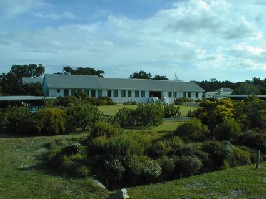 The
Hermanus Magnetic Observatory (HMO) The
Hermanus Magnetic Observatory (HMO)
|
The Hermanus Magnetic
Observatory
Extract
from the HMO's website at: www.hmo.ac.za/
"The Hermanus
Magnetic Observatory (HMO) is a research facility of the National
Research Foundation (www.nrf.ac.za),
which is an autonomous science council responsible for research
and human resources development in South
Africa. The HMO is situated
in the picturesque village
of Hermanus in the Western Cape (www.hermanus.co.za)".
The observatory is a participant
in a global network of similar institutions which "monitor
and model variations of the Earth's magnetic field".
|
For other SA Astronomy websites, go to the SpaceTides SA Astronomy
Portal at:
www.assabfn.co.za/spacetides/sa_astronomy.htm
|
7. Astronomy Events
in the City of Bloemfontein
|
The different astronomy organizations
in the City, working hand-in-hand to inform people about the interesting
world of astronomy and spaceflight, can be reached at the following addresses:
|
|
Boyden Observatory Science Centre:
www.assabfn.co.za/friendsofboyden/explore.htm
One
of the most publicly
accessible observatories of its
kind in the Southern Hemisphere, also housing SA's
third largest telescope. The next open evening is on
23 July 2005 (Saturday). Time: 18h30. R25 per vehicle. Snacks will
be sold. Special theme on Geology will be presented by the
Friends of Boyden. Phone 051-401 2322 for reservations or reply
to this email with the amount of people who will attend.
|
|
|
The Friends of Boyden: www.assabfn.co.za/friendsofboyden
A public interest group for Boyden Observatory and for people interested
in joining the astronomical community of
Bloemfontein, but not make
astronomy their "full-time" hobby.
Contact
Braam van Zyl at 051-436 7555 (h) or visit the website above.
Anyone can become a member. R50 membership fee per year for a whole
family. Members receive the latest information on astronomy events
in Bloem, attend the Friends' presentations free of charge
and receive the "Naghemel" quarterly newsletter
compiled by ASSA Bloemfontein by post.
|
|
|
ASSA Bloemfontein Centre: www.assabfn.co.za
Affiliated
with the Astronomical Society of Southern Africa, the Bloemfontein
Centre of ASSA is an active organization of amateur astronomers
meeting on a regular basis to discuss and practise astronomy. Activities
include solar-, lunar-, deep sky- and comet & meteor observations,
as well as historical research, telescope building, tours and away-weekends
under dark skies.
Send an e-mail
to mail@assabfn.co.za or visit the website.
Interested persons contact Phillip Coetzer: 084 627 7626.
|
Onthou ook om Boyden Sterrewag
se gereelde sterrekunde
berigte in die "Ons Stad" plaaslike koerant te lees.
Dit bevat ook meer
inligting rondom Boyden
besoektye.
-
Solarviews: www.solarviews.com
- A comprehensive astronomy website for beginners in astronomy
or anyone who wants to find general information on the solar system.
This is also a primary source of information used by SpaceTides.
- Google Earth: http://earth.google.com/
- A fascinating program
where you can zoom into almost any place on Earth. There are also
add-ons available for the specialized user. Download size: approx.
10 MB.
- The Society
for Popular Astronomy (UK):
www.popastro.com/home.htm
- with loads of information and also more specialized areas for
amateur astronomers.
- The Gateway
to Astronaut Photography: http://eol.jsc.nasa.gov/sseop/clickmap/
- A web-based utility to
zoom into satellite
photos taken of the Earth. Your city or town might also
be visible.
- Akira Fujii/DMI photo collection:
www.davidmalin.com/fujii/fujii_index.html
- Exquisite constellation and starfield
photos. Well worth the visit.
|
- Other links/news on the web:
|
- A smoking laptop caused
some panic on an Aussie plane: http://theinquirer.net/?article=24632
- Harry Potter craze has hit the streets again. Official
Harry Potter website: http://harrypotter.warnerbros.com/main/homepage/intro.html
- A few things to do before you are 10 years of age. If you
haven't done it yet, try it anyway! www.sky.com/skynews/article/0,,91059-13381613,00.html
- 50 places to see before you die calculator - how old will
you be by the time you see all?
http://www.twisty.com/misc/50places/
- On-line evolution: Lots of information on the Internet
itself (history, impact, dark sides, web jargon and lots more):
www.cnn.com/SPECIALS/2005/online.evolution/
- 2 meters and 36.1 cm - the world's tallest man. How's da weather up there hey? www.sky.com/skynews/article/0,,91059-13381900,00.html
- You bored? Visit bored.com and have a laugh or three...
http://www.bored.com/
|
SpaceTides is a free internet e-zine for persons interested in expanding their
general knowledge of astronomy and spaceflight.
The e-zine originates from the City of Bloemfontein in South Africa and
is compiled us a service to the public by ASSA Bloemfontein Centre
as part of their educational outreach activities. Website: www.assabfn.co.za.
SpaceTides contains links to various other third party sites on the
internet, not always connected to SpaceTides. The persons and entities
responsible
for compiling SpaceTides will not be held responsible for the content
or information on these third party sites or any damage of any kind
incurred from
downloading, opening, or viewing anything from/through these sites.
If you would like to unsubscribe from SpaceTides, send an e-mail
to spacetides@assabfn.co.za with the word
"Unsubscribe" in the subject line.
|



